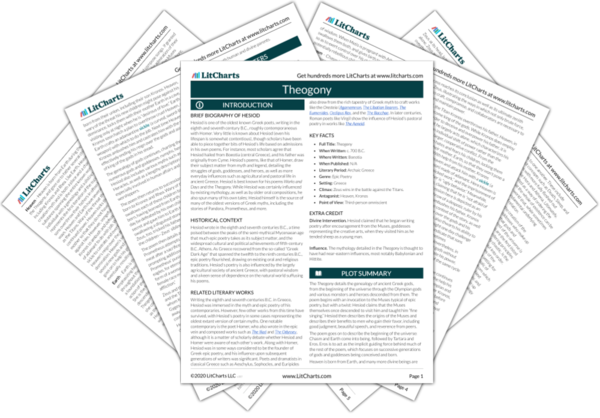Cycles of Succession
Throughout Hesiod’s Theogony, a poem from circa 700 B.C., the poet details the multiple successions that occur in the realm of the gods. From the origins of the first Greek gods and goddesses, to the rise of the Titans, to their overthrow by the Olympians, succession is shown to be a natural dynamic among the gods. However, this process reaches its conclusion as well as its ultimate zenith with Zeus, illustrating the ways…
read analysis of Cycles of SuccessionFamily and Genealogy
Throughout the Theogony, Hesiod details an extensive chronology of the various gods and goddesses, listing dozens of gods and their genealogies and relations to one another. These include personifications of abstract concepts such as Death, Sleep, and Memory, as well as divinities with more fully fleshed-out histories and personalities, like Hera and Athena. Ultimately, family and genealogy is presented as a way of ordering the universe. The poem suggests that the whole of…
read analysis of Family and GenealogyViolence and Power
Throughout the Theogony, violence is used as a necessary tool in order to obtain and preserve power by gods and humans alike. From the initial conflicts between successive generations of gods and goddesses, to the violent exploits of the Heroic Age, bloodshed and brutality are essential components of the poem. However, in the Theogony these acts of violence are not always entirely negative, but rather part and parcel with power, change, and generation—a necessary…
read analysis of Violence and Power
The Natural and Divine Worlds
In the Theogony, the poet describes the natural and the divine world as being closely linked and sometimes almost indistinguishable from one another, like in the instances of personified deities like the Winds, the Sea, and the Sun and Moon. This link between the natural and divine worlds emphasizes that humans are forced to rely on two forces larger than themselves—nature and divinity—in order to thrive. Ultimately, Hesiod makes the case in the poem…
read analysis of The Natural and Divine Worlds






